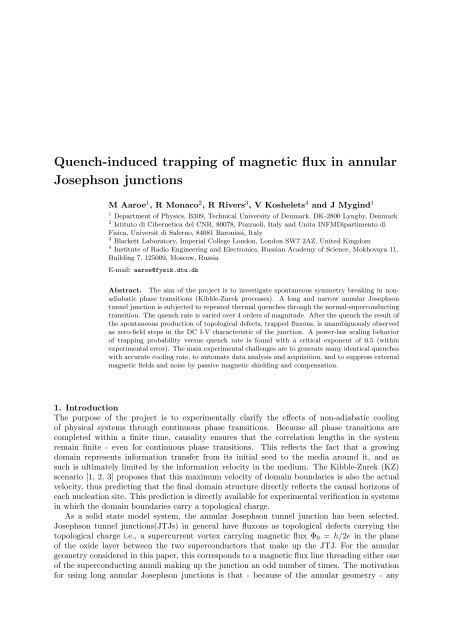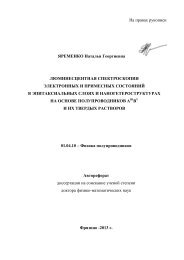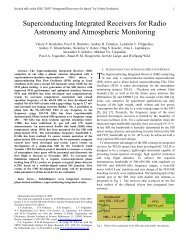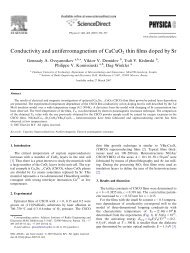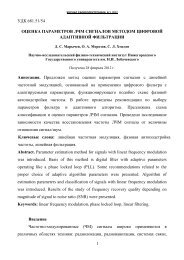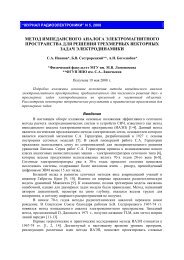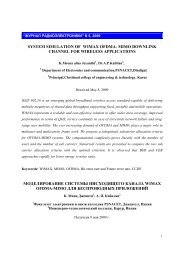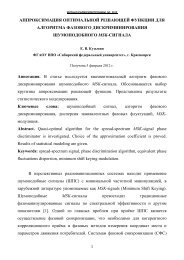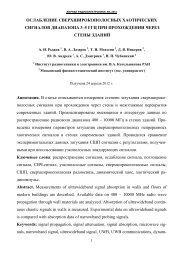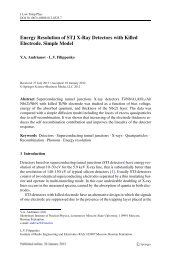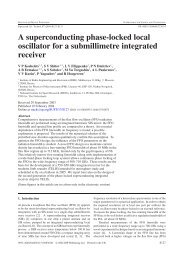Quench-induced trapping of magnetic flux in annular Josephson ...
Quench-induced trapping of magnetic flux in annular Josephson ...
Quench-induced trapping of magnetic flux in annular Josephson ...
You also want an ePaper? Increase the reach of your titles
YUMPU automatically turns print PDFs into web optimized ePapers that Google loves.
<strong>Quench</strong>-<strong><strong>in</strong>duced</strong> <strong>trapp<strong>in</strong>g</strong> <strong>of</strong> <strong>magnetic</strong> <strong>flux</strong> <strong>in</strong> <strong>annular</strong><br />
<strong>Josephson</strong> junctions<br />
M Aaroe 1 , R Monaco 2 , R Rivers 3 , V Koshelets 4 and J Myg<strong>in</strong>d 1<br />
1 Department <strong>of</strong> Physics, B309, Technical University <strong>of</strong> Denmark, DK-2800 Lyngby, Denmark<br />
2 Istituto di Cibernetica del CNR, 80078, Pozzuoli, Italy and Unita INFMDipartimento di<br />
Fisica, Universit di Salerno, 84081 Baronissi, Italy<br />
3 Blackett Laboratory, Imperial College London, London SW7 2AZ, United K<strong>in</strong>gdom<br />
4 Institute <strong>of</strong> Radio Eng<strong>in</strong>eer<strong>in</strong>g and Electronics, Russian Academy <strong>of</strong> Science, Mokhovaya 11,<br />
Build<strong>in</strong>g 7, 125009, Moscow, Russia<br />
E-mail: aaroe@fysik.dtu.dk<br />
Abstract. The aim <strong>of</strong> the project is to <strong>in</strong>vestigate spontaneous symmetry break<strong>in</strong>g <strong>in</strong> nonadiabatic<br />
phase transitions (Kibble-Zurek processes). A long and narrow <strong>annular</strong> <strong>Josephson</strong><br />
tunnel junction is subjected to repeated thermal quenches through the normal-superconduct<strong>in</strong>g<br />
transition. The quench rate is varied over 4 orders <strong>of</strong> magnitude. After the quench the result <strong>of</strong><br />
the spontaneous production <strong>of</strong> topological defects, trapped <strong>flux</strong>ons, is unambiguously observed<br />
as zero-field steps <strong>in</strong> the DC I-V characteristic <strong>of</strong> the junction. A power-law scal<strong>in</strong>g behavior<br />
<strong>of</strong> <strong>trapp<strong>in</strong>g</strong> probability versus quench rate is found with a critical exponent <strong>of</strong> 0.5 (with<strong>in</strong><br />
experimental error). The ma<strong>in</strong> experimental challenges are to generate many identical quenches<br />
with accurate cool<strong>in</strong>g rate, to automate data analysis and acquisition, and to suppress external<br />
<strong>magnetic</strong> fields and noise by passive <strong>magnetic</strong> shield<strong>in</strong>g and compensation.<br />
1. Introduction<br />
The purpose <strong>of</strong> the project is to experimentally clarify the effects <strong>of</strong> non-adiabatic cool<strong>in</strong>g<br />
<strong>of</strong> physical systems through cont<strong>in</strong>uous phase transitions. Because all phase transitions are<br />
completed with<strong>in</strong> a f<strong>in</strong>ite time, causality ensures that the correlation lengths <strong>in</strong> the system<br />
rema<strong>in</strong> f<strong>in</strong>ite - even for cont<strong>in</strong>uous phase transitions. This reflects the fact that a grow<strong>in</strong>g<br />
doma<strong>in</strong> represents <strong>in</strong>formation transfer from its <strong>in</strong>itial seed to the media around it, and as<br />
such is ultimately limited by the <strong>in</strong>formation velocity <strong>in</strong> the medium. The Kibble-Zurek (KZ)<br />
scenario [1, 2, 3] proposes that this maximum velocity <strong>of</strong> doma<strong>in</strong> boundaries is also the actual<br />
velocity, thus predict<strong>in</strong>g that the f<strong>in</strong>al doma<strong>in</strong> structure directly reflects the causal horizons <strong>of</strong><br />
each nucleation site. This prediction is directly available for experimental verification <strong>in</strong> systems<br />
<strong>in</strong> which the doma<strong>in</strong> boundaries carry a topological charge.<br />
As a solid state model system, the <strong>annular</strong> <strong>Josephson</strong> tunnel junction has been selected.<br />
<strong>Josephson</strong> tunnel junctions(JTJs) <strong>in</strong> general have <strong>flux</strong>ons as topological defects carry<strong>in</strong>g the<br />
topological charge i.e., a supercurrent vortex carry<strong>in</strong>g <strong>magnetic</strong> <strong>flux</strong> Φ 0 = h/2e <strong>in</strong> the plane<br />
<strong>of</strong> the oxide layer between the two superconductors that make up the JTJ. For the <strong>annular</strong><br />
geometry considered <strong>in</strong> this paper, this corresponds to a <strong>magnetic</strong> <strong>flux</strong> l<strong>in</strong>e thread<strong>in</strong>g either one<br />
<strong>of</strong> the superconduct<strong>in</strong>g annuli mak<strong>in</strong>g up the junction an odd number <strong>of</strong> times. The motivation<br />
for us<strong>in</strong>g long <strong>annular</strong> <strong>Josephson</strong> junctions is that - because <strong>of</strong> the <strong>annular</strong> geometry - any
<strong>flux</strong>ons created dur<strong>in</strong>g the quench, will be trapped <strong>in</strong> the junction until it is reheated, because<br />
<strong>of</strong> the Meissner effect <strong>of</strong> the superconduct<strong>in</strong>g annuli. This is schematically illustrated <strong>in</strong> figure<br />
1(a).<br />
(a) Simplified illustration <strong>of</strong> a trapped <strong>flux</strong>on <strong>in</strong> an<br />
<strong>annular</strong> <strong>Josephson</strong> tunnel junction. It is seen that<br />
the <strong>magnetic</strong> <strong>flux</strong> loop threads only one <strong>of</strong> the r<strong>in</strong>gs.<br />
(b) Actual geometry <strong>of</strong> <strong>annular</strong> <strong>Josephson</strong> tunnel<br />
junction no. 4, designated JJ4. The geometry <strong>of</strong><br />
no. 3 (JJ3) is similar, only the ground plane is<br />
without circular hole.<br />
Figure 1. Model and real geometry <strong>of</strong> the <strong>annular</strong> <strong>Josephson</strong> junctions. In both cases, the<br />
perpendicular dimension is exagerated.<br />
The creation <strong>of</strong> an <strong>flux</strong>on, and thereby a closed, oriented <strong>magnetic</strong> loop, <strong>in</strong>to the system is<br />
an example <strong>of</strong> a spontaneous symmetry break<strong>in</strong>g event; the perpendicular up-down symmetry<br />
<strong>of</strong> the system is broken by the directionality <strong>of</strong> the B-field. A key po<strong>in</strong>t to make is that the<br />
symmetry-break<strong>in</strong>g mechanism itself (ie. the cool<strong>in</strong>g) is symmetrical, and thus is not the direct<br />
cause <strong>of</strong> the break <strong>in</strong> symmetry.<br />
2. Theory<br />
An idealised model was proposed <strong>in</strong> 2000 [4] to test the KZ scenario for <strong>annular</strong> JTJs, assum<strong>in</strong>g<br />
that causal horizons are constra<strong>in</strong>ed only by the velocity <strong>of</strong> electro<strong>magnetic</strong> waves <strong>in</strong> the junction,<br />
the Swihart velocity [5, 6]. As a result, the probability f 1 for spontaneously produc<strong>in</strong>g one<br />
<strong>flux</strong>on <strong>in</strong> the thermal quench <strong>of</strong> a symmetric <strong>annular</strong> <strong>Josephson</strong> junction <strong>of</strong> circumference C was<br />
predicted to scale with the quench time τ Q (the <strong>in</strong>verse quench rate) as<br />
f 1 ≃ C¯ξ = C ξ 0<br />
( τQ<br />
τ 0<br />
) −σ<br />
, (1)<br />
where the scal<strong>in</strong>g exponent σ depends on the system. In Eq.(1), ¯ξ is the Kibble-Zurek causal<br />
length, the correlation length <strong>of</strong> the relative <strong>Josephson</strong> phase angle at the time <strong>of</strong> defect<br />
formation. The relative <strong>Josephson</strong> phase angle is the space-dependent difference <strong>in</strong> phase<br />
between the superconduct<strong>in</strong>g wavefunctions <strong>of</strong> the two r<strong>in</strong>gs mak<strong>in</strong>g up the <strong>annular</strong> josephson<br />
junction. The <strong>trapp<strong>in</strong>g</strong> probability is def<strong>in</strong>ed through Eq.(1) <strong>in</strong> terms <strong>of</strong> the zero-temperature<br />
correlation length ξ 0 , the relaxation time τ 0 <strong>of</strong> the long wavelength modes <strong>of</strong> the superconduct<strong>in</strong>g<br />
wavefunction, and the quench time τ Q , <strong>in</strong> turn def<strong>in</strong>ed by: T C /τ Q = −(dT/dt) T =TC . Eq.(1)<br />
holds for C < ¯ξ, where ¯ξ is the frozen-<strong>in</strong> correlation length, roughly equivalent to the size <strong>of</strong><br />
fluctuations <strong>in</strong> the superconduct<strong>in</strong>g wavefunction at the time <strong>of</strong> freez<strong>in</strong>g. The probability f 1<br />
is the sum <strong>of</strong> the probabilities <strong>of</strong> all the different ways <strong>of</strong> thread<strong>in</strong>g the geometry by a closed<br />
<strong>magnetic</strong> field loop, <strong>in</strong> such a way, that the field loop <strong>in</strong>tersects the tunnel barrier oxide just<br />
once, regardless <strong>of</strong> direction.
In theory, the creation <strong>of</strong> a <strong>flux</strong>on with direction <strong>in</strong> through the oxide towards the center<br />
<strong>of</strong> the annulus, and the creation <strong>of</strong> one with opposite direction should be equally probable.<br />
However, because <strong>of</strong> the detection mechanism <strong>in</strong>herent to this setup, there is no obvious way<br />
to discrim<strong>in</strong>ate between the two states. Us<strong>in</strong>g the current detection scheme (see section 3.3)<br />
results <strong>in</strong> the same outcome regardsless <strong>of</strong> the directionality <strong>of</strong> the <strong>flux</strong>on.<br />
3. Measurements<br />
The actual experimental procedure consists <strong>of</strong> a large number <strong>of</strong> heat<strong>in</strong>g-cool<strong>in</strong>g-measurement<br />
cycles for different cool<strong>in</strong>g rates. For each cycle, the sample is electrically heated, passively<br />
cooled without electrical connections and f<strong>in</strong>ally the actual detection takes place.<br />
3.1. Thermal control<br />
The thermal part <strong>of</strong> the cycle is performed by electrical heat<strong>in</strong>g by resistive strips <strong>in</strong> either end<br />
<strong>of</strong> the sample, as seen <strong>in</strong> figure 2. In order to avoid electro<strong>magnetic</strong> noise <strong><strong>in</strong>duced</strong> by current<br />
noise <strong>in</strong> the heaters, the heat<strong>in</strong>g pulse is mechanically switched <strong>of</strong>f outside <strong>of</strong> the cryoprobe<br />
dur<strong>in</strong>g cool<strong>in</strong>g and measurements. Cool<strong>in</strong>g takes place passively through the helium exchange<br />
gas (approximately 7-8 mbar <strong>of</strong> pressure) as well as through the copper sample holder. The<br />
cool<strong>in</strong>g rate can be controlled by the exchange gas pressure and the heat<strong>in</strong>g time. For longer<br />
heat<strong>in</strong>g times, more <strong>of</strong> the copper sample holder is heated along with the silicon sample. This<br />
gives a larger effective heat capacity <strong>of</strong> the total system, and thus a slower cool down.<br />
Figure 2. Layout <strong>of</strong> one <strong>of</strong> the samples used <strong>in</strong> measurements. For this geometry, the four<br />
junctions are numbered 1 through 4 from left to right. The dimensions <strong>of</strong> the whole sample<br />
is 3mm by 4.2mm. The meander l<strong>in</strong>es seen at either end <strong>of</strong> the sample are resistors used for<br />
heat<strong>in</strong>g.<br />
For slow quenches, a solid-state germanium resistor mounted <strong>in</strong> the copper sample holder<br />
is used to determ<strong>in</strong>e τ Q . However, for faster quenches, <strong>in</strong> which τ Q is less than a few seconds,<br />
thermal equilibrium is not obta<strong>in</strong>ed between the sample and the sample holder. For this, a much<br />
faster thermometer is required. This is supplied by the device itself, as the <strong>Josephson</strong> junction<br />
can be used as a transition edge thermometer <strong>in</strong> constant-current bias mode. The junction is<br />
biased at 25-30% <strong>of</strong> the maximum gap current, and the voltage response as a function <strong>of</strong> time<br />
is measured, see fig. 3(a). This can be directly converted <strong>in</strong>to a temperature as long as T < T C<br />
for the junction [10]. As τ Q is decided by the time-derivative <strong>of</strong> the temperature <strong>of</strong> the device<br />
at T = T C an extrapolation is performed to this us<strong>in</strong>g a simple thermal relaxation model. In<br />
general, the fit to the thermal model is excellent (correllation coefficient, R 2 > 0.98) as is seen<br />
<strong>in</strong> fig. 3(b).
(a) Gap voltage <strong>of</strong> a DC current biased <strong>annular</strong><br />
<strong>Josephson</strong> junction as a function <strong>of</strong> time. Heat<strong>in</strong>g<br />
is turned on at t=0s and <strong>of</strong>f around t=0.02s<br />
(b) Example <strong>of</strong> result <strong>of</strong> conversion <strong>of</strong> post-T C<br />
part <strong>of</strong> the gap voltage graph to temperature.<br />
The overly<strong>in</strong>g l<strong>in</strong>e is the fit to a simple thermal<br />
relaxation model.<br />
Figure 3. Illustration <strong>of</strong> the thermometry measurements <strong>in</strong>volved <strong>in</strong> the experiments. τ Q can<br />
be found from the slope <strong>of</strong> the fit <strong>in</strong> 3(b) at T = T C , which is 9.2K for these samples.<br />
3.2. Magnetic shield<strong>in</strong>g and compensation<br />
The <strong>magnetic</strong> shield<strong>in</strong>g is implemented us<strong>in</strong>g a comb<strong>in</strong>ation <strong>of</strong> cryoperm and superconduct<strong>in</strong>g<br />
shields. The cryostat has 2 layers <strong>of</strong> cryoperm built <strong>in</strong>to it. The cryoprobe itself <strong>in</strong>corporates 3<br />
more passive <strong>magnetic</strong> shields - first a superconduct<strong>in</strong>g Pb shield, then a cryoperm shield, and<br />
f<strong>in</strong>ally another superconduct<strong>in</strong>g Pb shield. The alternation <strong>of</strong> cryoperm and superconduct<strong>in</strong>g<br />
shields makes for a large suppression <strong>of</strong> both AC and DC <strong>magnetic</strong> fields.<br />
In addition a superconduct<strong>in</strong>g coil has been built around the sample for compensation. The<br />
general approach to compensat<strong>in</strong>g <strong>magnetic</strong> fields is to assume the field is low. It is assumed<br />
that <strong>in</strong> this limit, any <strong>in</strong>crease <strong>in</strong> B-field strength will <strong>in</strong>crease <strong>trapp<strong>in</strong>g</strong> probability through<br />
<strong><strong>in</strong>duced</strong> <strong>trapp<strong>in</strong>g</strong>. Therefore, the compensation <strong>magnetic</strong> field, perpendicular to the sample, can<br />
be calibrated to the nearest m<strong>in</strong>imum <strong>in</strong> <strong>flux</strong>on <strong>trapp<strong>in</strong>g</strong> probability. A thorough theoretical<br />
treatment <strong>of</strong> this is <strong>in</strong> preparation [9].<br />
3.3. Detection<br />
The detection <strong>of</strong> trapped <strong>flux</strong>ons <strong>in</strong> the <strong>annular</strong> <strong>Josephson</strong> junction is performed by detection<br />
<strong>of</strong> zero-field steps. These are generated by <strong>in</strong>ternal resonances <strong>in</strong> the junction only available <strong>in</strong><br />
the presence <strong>of</strong> trapped <strong>flux</strong>ons. For a theoretical description <strong>of</strong> this see [6, 7].<br />
Zero-field steps <strong>in</strong> an <strong>annular</strong> <strong>Josephson</strong> junction can be seen <strong>in</strong> the DC I-V curve <strong>of</strong> the<br />
junction as voltage steps at voltages decided by the geometry <strong>of</strong> the junction itself. For the<br />
junctions <strong>in</strong> question, the voltages <strong>of</strong> the first zero-field step are on the order <strong>of</strong> a few to several<br />
tens <strong>of</strong> microvolts. The detection <strong>of</strong> zero-field steps is performed by an algorithm developed for<br />
the purpose. Detection accuracy is ¿95% measured aga<strong>in</strong>st manual evaluation <strong>of</strong> the I-V curves.<br />
4. Results<br />
As expected, a m<strong>in</strong>imum fairly close to zero is seen <strong>in</strong> the dependence <strong>of</strong> <strong>trapp<strong>in</strong>g</strong> rate, f, on<br />
B-field strength (fig. 4). However, the side peaks were not expected. It is seen, that when<br />
the <strong>magnetic</strong> field reaches a certa<strong>in</strong> value, the <strong>trapp<strong>in</strong>g</strong> rate decreases with <strong>in</strong>creas<strong>in</strong>g <strong>magnetic</strong><br />
field. This somewhat counter<strong>in</strong>tuitive behaviour is currently be<strong>in</strong>g <strong>in</strong>corporated <strong>in</strong>to a unified<br />
model <strong>of</strong> the KZ effect <strong>in</strong> the presence <strong>of</strong> a pre-exist<strong>in</strong>g symmetry-break<strong>in</strong>g field, and a paper is<br />
<strong>in</strong> preparation [9].
Figure 4. The variation <strong>of</strong> <strong>trapp<strong>in</strong>g</strong> rate with <strong>magnetic</strong> field. The central m<strong>in</strong>imum is clearly<br />
expressed, as well as two side peaks.<br />
Figure 5. A clear, systematic scal<strong>in</strong>g <strong>of</strong> s<strong>in</strong>gle-<strong>flux</strong>on <strong>trapp<strong>in</strong>g</strong> probability as a function <strong>of</strong><br />
quench time is found. The critical exponent is 0.51 ± 0.03.<br />
The ma<strong>in</strong> result <strong>of</strong> the experiments is shown on figure 5. It represents the condensation <strong>of</strong><br />
a few 100.000 thermal quenches. The po<strong>in</strong>ts are very closely distributed around the prediction<br />
<strong>of</strong> eq. (1). The different markers <strong>in</strong>dicate different samples and/or junctions used. They are,<br />
however, all <strong>of</strong> the same basic geometry as shown <strong>in</strong> figure 2.<br />
5. Discussion<br />
In order for this system to be a good model for a general cont<strong>in</strong>uous phase transition a number <strong>of</strong><br />
high-level assumptions were made: (1) The phase transition <strong>of</strong> the <strong>annular</strong> <strong>Josephson</strong> junction
is cont<strong>in</strong>uous, (2) The temperature is at all times approximately constant over a length larger<br />
than the dimensions <strong>of</strong> the junction, (3) The perpendicular symmetry <strong>of</strong> the junction is not<br />
broken by residual <strong>magnetic</strong> fields.<br />
It is possible to question all <strong>of</strong> the above assumptions on different grounds. The first<br />
assumption requires that there is no latent heat <strong>in</strong>volved <strong>in</strong> the phase transition. This is true for<br />
bulk superconductor <strong>in</strong> zero <strong>magnetic</strong> field. However, for a multiply connected superconductor,<br />
such as an annulus, <strong>in</strong> which a <strong>magnetic</strong> <strong>flux</strong> loop is spontaneously generated, this is only<br />
approximately true. The k<strong>in</strong>etic energy <strong>of</strong> the cooper pairs <strong>in</strong> the screen<strong>in</strong>g current <strong>in</strong> the<br />
annulus should be taken <strong>in</strong>to account as a rather exotic form <strong>of</strong> latent heat, if a <strong>flux</strong>on is<br />
trapped, and it turns out that this energy is on the same order as the thermal energy k B T<br />
at the transition. The second assumption is essentially a question <strong>of</strong> the timescales <strong>in</strong>volved<br />
<strong>in</strong> the heat<strong>in</strong>g as compared to the heat transfer along the sample from the heaters on either<br />
end. If the time constant for heat transfer along the length <strong>of</strong> the sample is significantly lower<br />
than the quench time, τ Q , the assumption is fulfilled. This can be verified by either heatflow<br />
simulations or analytical approximations. F<strong>in</strong>ally, the third assumption seems to be the<br />
hardest to fulfill. One has to f<strong>in</strong>d a logical limit to how much <strong>magnetic</strong> field should be allowed,<br />
without expect<strong>in</strong>g it to <strong>in</strong>terfere with the phase transition. The simplest choice is to require<br />
the <strong>magnetic</strong> <strong>flux</strong> through the r<strong>in</strong>g to be significantly less than one <strong>magnetic</strong> <strong>flux</strong> quantum per<br />
r<strong>in</strong>g area, B < Φ 0 /A r<strong>in</strong>g =<br />
h/2e . This has been tested by plac<strong>in</strong>g a SQUID device <strong>of</strong> higher<br />
C 2 /4π<br />
sensitivity <strong>in</strong> the immediate vic<strong>in</strong>ity <strong>of</strong> the sample. The SQUID has been rotated to measure<br />
the absolute value <strong>of</strong> the B-field as well as the noise level, and both have been seen to be below<br />
this limit. One f<strong>in</strong>al note should be to mention that the pulsed current runn<strong>in</strong>g through the<br />
heaters will <strong>in</strong>duce an oscillat<strong>in</strong>g <strong>magnetic</strong> field <strong>in</strong> the coil, and should therefore be temporally<br />
separated from the phase transition by a time larger than a few times the relaxation time <strong>of</strong> the<br />
coil system.<br />
6. Conclusion<br />
It has been shown that the probability <strong>of</strong> <strong>trapp<strong>in</strong>g</strong> a <strong>flux</strong>on <strong>in</strong> an <strong>annular</strong> <strong>Josephson</strong> tunnel<strong>in</strong>g<br />
junction scales with a power law dependence on the <strong>in</strong>verse cool<strong>in</strong>g rate at the time <strong>of</strong> transition<br />
<strong>in</strong> good agreement with the prediction <strong>of</strong> Zurek [1, 2]. In particular the critical exponent <strong>of</strong><br />
this system is 0.5 to a great accuracy. It has been shown on different samples and on <strong>annular</strong><br />
junctions <strong>of</strong> different sizes and detailed geometry.<br />
This experiment rema<strong>in</strong>s to this day the only solid-state experiment to show reliable Kibble-<br />
Zurek scal<strong>in</strong>g behaviour.<br />
References<br />
[1] Zurek W H, 1985 Nature 317 505<br />
1993 Acta Physica Polonica B24 1301.<br />
[2] Zurek W H 1996 Phys. Rep. 276 Number 4.<br />
[3] Kibble T W B 1980 <strong>in</strong> Common Trends <strong>in</strong> Particle and Condensed Matter Physics, Phys. Rep. 67, 183.<br />
[4] Kavoussanaki E, Monaco R and Rivers R J 2000 Phys. Rev. Lett. 85, 3452.<br />
Monaco R, Rivers R J and Kavoussanaki E 2001 J. <strong>of</strong> Low Temp. Phys. 124, 85.<br />
[5] Swihart J C 1961 J. Appl. Phys. 32 461.<br />
[6] Barone A and Paterno G 1982 Physics and Applications <strong>of</strong> the <strong>Josephson</strong> Effect (New York, John Wiley &<br />
Sons).<br />
[7] Van Duzer T and Turner C W 1999 Pr<strong>in</strong>ciples <strong>of</strong> Superconductive Devices and Circuits (Upper Saddle River,<br />
Prentice Hall).<br />
[8] Monaco R, Myg<strong>in</strong>d J, and Rivers R J 2002 Phys. Rev. Lett. 89 080603.<br />
Monaco R, Myg<strong>in</strong>d J, and Rivers R J 2003 Phys.Rev. B 67 104506.<br />
[9] Monaco R, Aaroe M, Myg<strong>in</strong>d J, Koshelets V P and Rivers R J, <strong>in</strong> preparation.<br />
[10] Thouless D J 1960 Phys.Rev. 117 1256.


